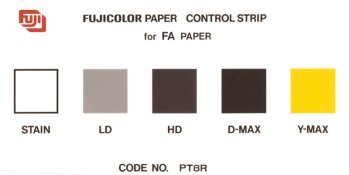- Joined
- Sep 9, 2005
- Messages
- 868
- Format
- 35mm
These came from a FOAF by way of our mutual friend. The FOAF now runs the photo lab at a local Wally World, and I can imagine this guy as a real stickler for quality control. He did admit that he knows of other labs which are not very meticulous in the process.
They use Fuji Frontier equipment and do a daily QA on the machines to test the chemistry and the overall results of processing.
The one on the left is a pre-exposed negative control strip. This is run through the negative processor before any customer jobs are done each day and it's then checked with a densitometer. The D-min and D-max should be obvious as to purpose. The HD and LD are high and low test points to verify the linearity of the processing. I'm not real clear on the Y-patch. He said something about this showing residual silver and that chemistry that's going bad will show up on this one.
The one on the right is a paper control strip, and again it's (supposed to be) checked with a densitometer although he said that some labs just eyeball-check it. The "stain" square is supposed to be totally white and the D-max totally black, with LD and HD being certain shades of grey with no color cast. I'm not really sure about the Y-max, but it appears to be a solid yellow. (Anybody know? Class?)
I thought that the gang here would find this of interest. I did.
They use Fuji Frontier equipment and do a daily QA on the machines to test the chemistry and the overall results of processing.
The one on the left is a pre-exposed negative control strip. This is run through the negative processor before any customer jobs are done each day and it's then checked with a densitometer. The D-min and D-max should be obvious as to purpose. The HD and LD are high and low test points to verify the linearity of the processing. I'm not real clear on the Y-patch. He said something about this showing residual silver and that chemistry that's going bad will show up on this one.
The one on the right is a paper control strip, and again it's (supposed to be) checked with a densitometer although he said that some labs just eyeball-check it. The "stain" square is supposed to be totally white and the D-max totally black, with LD and HD being certain shades of grey with no color cast. I'm not really sure about the Y-max, but it appears to be a solid yellow. (Anybody know? Class?)

I thought that the gang here would find this of interest. I did.





 . It soon became a moot point anyway because Agfa who had supplied the machine, sank, probably more telling though, the equipment was not replaced. I switched to using a pro-lab which cost more, but they always provided excellent results, even though they also used a mini-lab (Fuji Frontier) negatives always came back spotless and the prints were also excellent. I went back to my B&W roots shortly there after and processed my own film again. Used a hybrid setup for a while, until I went d*****l, to tell how well that went, I am back to film for B&W again. Even debating about trying large format, of course that leaves friends and family who are worshipping the megapixel slightly :confused:
. It soon became a moot point anyway because Agfa who had supplied the machine, sank, probably more telling though, the equipment was not replaced. I switched to using a pro-lab which cost more, but they always provided excellent results, even though they also used a mini-lab (Fuji Frontier) negatives always came back spotless and the prints were also excellent. I went back to my B&W roots shortly there after and processed my own film again. Used a hybrid setup for a while, until I went d*****l, to tell how well that went, I am back to film for B&W again. Even debating about trying large format, of course that leaves friends and family who are worshipping the megapixel slightly :confused:
